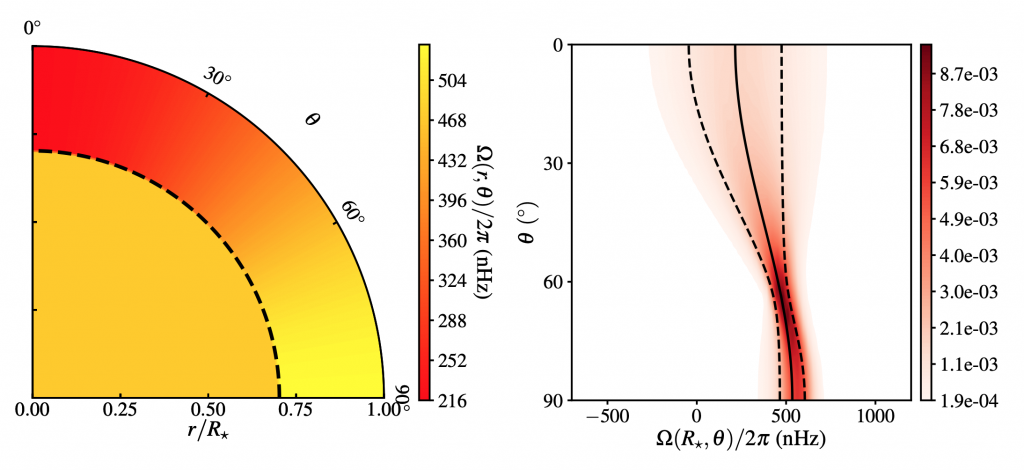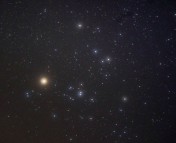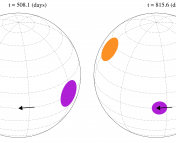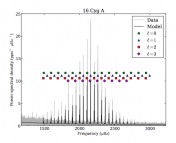Title: Latitudinal differential rotation in the solar analogues 16 Cyg A and B
Authors: M. Bazot, O. Benomar, J. Christensen-Dalsgaard, L. Gizon, S. Hanasoge, M. Nielsen, P. Petit, and K. R. Sreenivasan
First Author’s Institution: Division of Sciences, New York University Abu Dhabi, United Arab Emirates
Status: Accepted in Astronomy & Astrophysics
Note: A coauthor on this work, M. Nielsen, very recently joined the research group I am a part of. However his affiliation with this paper is only through his previous institution, and I have had no involvement with this work.
Turn! Turn! Turn!
It’s not something you normally picture, but every star in the night sky is spinning. Some stars, like the Sun, spin relatively slowly, one rotation every 25 days. Some others, in less than a day! Rotation rates are an important and useful way of understanding stars. For example, for stars burning hydrogen in their cores like the Sun (called Main Sequence stars), the rotation rate is known to be linked to the stars colour and its age.
Rotation also plays a lead role in the most prominent theory explaining changes in magnetic activity of our Sun, which varies in a roughly-periodic 11-year cycle. The particular aspect of the Sun’s rotation that is relevant to this theory is differential rotation, the change in rotation rates of the solar material at different latitudes. It is known that the Sun rotates about 1.4 times as fast at the equator than it does at the poles, and that this holds true both for the solar surface, and the layer beneath the surface where convection happens, suggesting a possible relationship between the mechanism of convection and differential rotation. The Sun is only one star, however; if we really want to understand the impact of differential rotation on the physics of stars, we need to expand our search beyond the solar system.
The authors of today’s paper set out to expand our knowledge of differential rotation in other stars like the Sun. They studied two stars in a binary pair, 16 Cyg A & B, two solar analogues, in the sense that they have similar physical characteristics to the Sun. What makes these stars especially interesting in this study is that they have rotation rates that are similar to the Sun. This raises the question: do we observe rates of differential rotation in these stars that are similar to the Sun, or are they different, and why?

Right panel: The rotation rate on the x-axis, with the co-latitude this time on the y-axis. The spread of the colour shows the uncertainty on the rotation profile, and the dotted lines indicate the standard deviation on the mean value for the rotation, which is represented by the thick line. As we get closer to the poles, the models become less certain of the rotation rate, as asteroseismology in general struggles to probe these regions. [Figure 4 in the paper]
A stellar symphony
The tool the authors use to study this stellar pair is asteroseismology: the study of stellar pulsations inside stars. The pulsations (or oscillations) cause the stars brightness to change slightly at regular intervals. By studying tiny variations in a star’s brightness over time, astronomers can observe the series of oscillations inside a star. In the same way that music depends on the instrument, so do stellar oscillations depend on the properties of a star, allowing us to characterise stellar systems in great detail.
16 Cyg A & B are some of the brightest stars measured by Kepler, and therefore have extremely detailed measurements of the stars’ asteroseismic pulsations. This signal has been previously used to measure their rotation, by looking at the spacing between frequencies of different oscillations. Today’s authors take this a step further, by including additional terms in their model that describe the tiny shifts in oscillation frequencies that would happen were the star to be rotating differentially.
Measure it, invert it
Using the measurements of shifts in the asteroseismic signal, the authors can perform an inversion: taking their measured data, and constructing a model of the stars internal rotation profile (like shaking a birthday present to deduce what’s inside). This rotation profile is shown for 16 Cyg A in Figure 1, above. They find a clear indication of differential rotation, and find rotation rates well constrained near the equator. Near the polar region the rotation is less constrained, but this is expected, as asteroseismology struggles to probe these regions in general.
For 16 Cyg A, the authors find that the star rotates at a rate of ~2.5 times as fast as at the poles. For 16 Cyg B, they find a ratio of ~2.6, making these stars consistent with one another (as you would expect for a binary system!), but not entirely similar to the Sun. They note, however, that this is difficult to confirm due to the large uncertainties, and that improvement of the models used for the inversion technique will reduce this uncertainty in future work.

What’s next in rotation?
These measurements, the very first of stars with rotations analogous to the Sun, join a steadily growing cohort of differential rotation measurements of Main Sequence stars (see Figure 2). Despite being similar to the Sun, 16 Cyg A & B have differential rotation that is measured to be significantly larger than that in the Sun. The uncertainties on these measurements are still large however, and will be reduced by future refinement of models. Most importantly, these detections show that the authors’ method of measurement and inversion is feasible for solar analogues. With current and upcoming missions such as TESS and PLATO, which provide asteroseismic data, we will be able to increase our sample of differential rotators even further. With this, we can improve our models, and, one day in the near future, understand more closely how our Sun fits in to the bigger picture of Sun-like stars.




